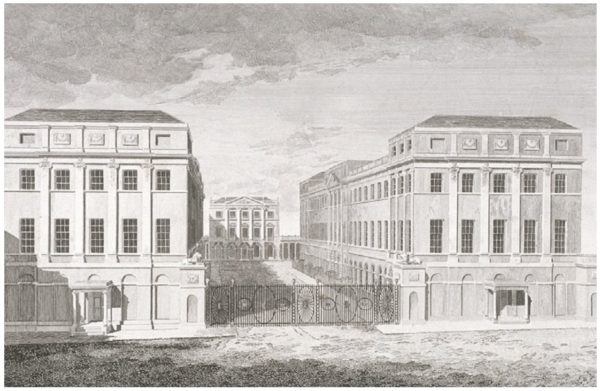Opposite Bond Street tube station can be found a small brick building, with a lion on top. At least, you can usually, as for the past few years it’s been covered in Crossrail hoardings, as the building next to it was demolished to make space for an upgrade of the tube station.
Fortunately, the tiny brick building was saved, and new images of the planned shops/block of flats that will be built here have confirmed that the odd little thing will remain in place.
But what is it?
It is the remaining one of a pair that used to stand on either side of the road fronting onto Oxford Street.
This was the London residence of the Earl of Aldborough, who leased the land from City of London (it used to be their Banqueting House), where he built a grand residence, Stratford Place, in 1771-4. Consisting of two uniform rows of houses, leading to a small square to the north side closed by the Classical front of Aldborough House (now Stratford House). The entrance was marked on the Oxford Street front by two brick gatehouses, crowned by lions, originally closed by railings and a gate.
The road is the sort of road that grand people visiting grand buildings would expect to see staff waiting for them — and the odd little building on the corner is a porters lodge, to carry bags and the like for the grand visitors.
There used to be two, but sadly the western partner was removed in 1915 when the current building there was erected as a Lyons tea house.
Fortunately the remaining lodge is now protected as a heritage asset.
The protection is a slight surprise, as it sat next to a rather “of its time” concrete building from 1969, replacing an 1890s bank, and keeping the totally out of place 18th century brick box next to their new concrete block must have irked the architects Seifert and Partners no end.
There have been attempts in the past to reuse the porters lodge as a small retail cubicle, but Westminster Council keep refusing, which is wise.
The 1969 building was demolished during Crossrail works, as underneath two huge shafts were dug down to the tunnels to provide access to the construction site, and one of them was later reused as a lift shaft.
Now that the concrete office block has gone, it’s to be replaced with a less distinctive, but more appropriate for the area brick building with shops and flats, and the old porters lodge, temporarily removed during the Crossrail works, is to be restored.
The old lion of Oxford Street will be back.












Excellent winkling-out, Ian. Fascinating – thank you!
As usual, an interesting gem of information relating to something I’ve walked past hundreds of times and idly thought – I wonder what that’s a relic from!
Have just donated a little to contribute to your ongoing research.
Thanks Ian – another fascinating thing to look out for when I’m allowed back into Central London!
Thanks for what youdo – stay safe.
Thanks for this. I was going to ask what Stratford House is now used as, as it always looks like an embassy, but apparently it’s a club (not like the Ministry of Sound).
https://en.wikipedia.org/wiki/Oriental_Club
On the site of the old Lyons tea House, so where the other Lion stood is the HMV building. I worked there when it was Lilley and Skinner and it’s basements hold the original street facade, with pavement, bow windows and little shop fronts; clearly hundreds of years old.They probably pre date the Earl’s, banqueting house as they are on a level below the current level on which the Lion stands. These were hidden behind the stock rooms and to my knowledge are still there. Further down in the basements are rooms known as the dungeons and the story was that they held prisoners waiting to transfer to Tyburn, up the road, to be hung.
Sorry – but that’s a total myth.
The building replaced a grand building that never had shop frontages to preserve, and certainly not in their basement where shoppers would never have seen them — the same for the claims about the jail.
I see this story crop up time and again with people claiming to have been in there, and yet even the most cursory searches of the area’s history will show it’s not possible, and more recent survey works for Crossrail etc show no such basements.
I managed Lilley and Skinnner in the 80’s we had 600 staff 5 trading floors and Garfunkels on the top floor with children’s shoes, Stanley Millington was my assistant, the behind the wall story is true but the dating is wrong, the facades and floors of the previous buildings were still there in mid eighties. The buildings were dated as 1600 or circa and the street glass lights were In place to protect the buildings but In reality the shop fronts were under the pavement line, at the far end there was a step staircase in stone up to the street level that was boxed off for air trunking. The street pavement was laid on steel and stone to give the pavement lights support. Madame Tusauds owners looked at the ‘hidden fronts and two story units with a view to restoration but it was impractical due to ceiling g height variations
Interesting article, I’ll look out for the lion when I’m next in the area. If only I could travel inside a time machine but this is the next best thing. Thank you.
PS I’d be happy to contribute when I’m working.🍀
PS. Take care and stay safe.